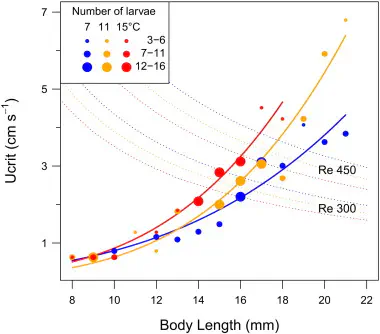Thermal impacts on the growth, development and ontogeny of critical swimming speed in Atlantic herring larvae
 Ontogeny of critical swimming speed in larvae of Atlantic herring reared at 7, 11, and 15 °C. Image credit: Marta Moyano
Ontogeny of critical swimming speed in larvae of Atlantic herring reared at 7, 11, and 15 °C. Image credit: Marta Moyano
Abstract
Increases in swimming ability have a profound influence on larval fish growth and survival by increasing foraging success, predator avoidance and the ability to favorably influence transport. Understanding how development and environmental factors combine to influence swimming performance in aquatic organisms is particularly important during the transition from viscous to inertial environments. We measured the growth, development and ontogenetic changes in critical swimming speed (Ucrit) in Atlantic herring (Clupea harengus) larvae reared at three temperatures (7, 11, 15 °C). Temperature had a significant effect on growth rates (from 0.21 at 7 °C to 0.34 mm⋅d− 1 at 15 °C), and larval morphology-at-length (increased dry weight (DW), body height and developmental rate at warmer temperatures). Temperature-dependent differences in morphology influenced swimming performance (e.g. the exponential increase in Ucrit with increasing body size was faster at warmer temperatures). Larvae entered the transition to an inertial environment (Reynolds numbers ≥ 300) at body lengths between 15 (15 °C) and 17 mm (7 °C). Inter-individual differences in Ucrit were not related to nutritional condition (RNA⋅DNA− 1 or DNA⋅DW− 1), but were negatively correlated to length-at-age, suggesting a trade-off between growth rate and locomotor activity. The Ucrit data from this and previously published studies suggest that Atlantic herring pass through four activity phases: 1) yolk-sac (< 0.6 cm⋅s− 1), 2) pre-flexion (0.6–3.0 cm⋅s− 1, temperature effect changes with body size), 3) post-flexion (up to 6–8 cm⋅s− 1, Q10 ∼ 1.8–2.0), 4) juvenile–adult period (20–170 cm⋅s− 1).